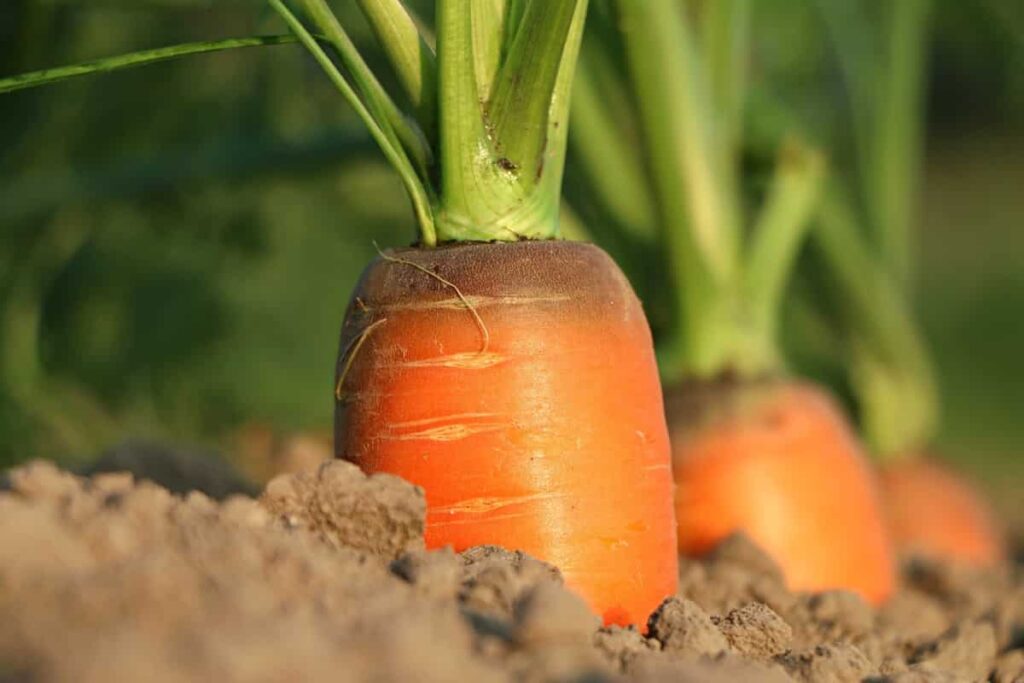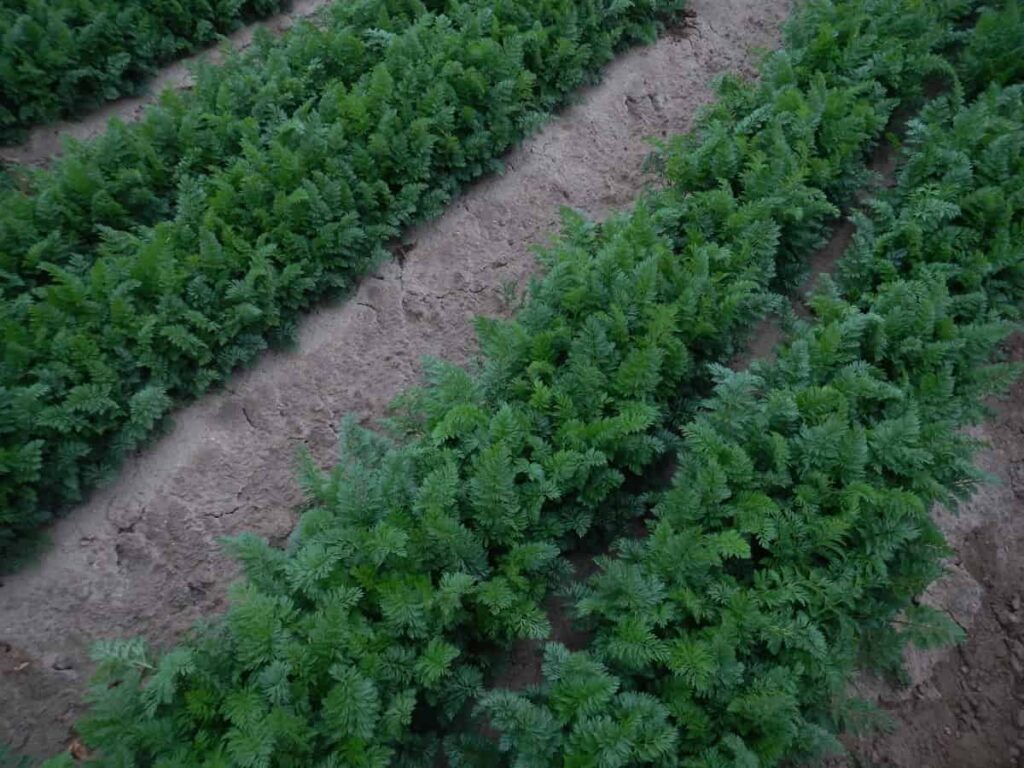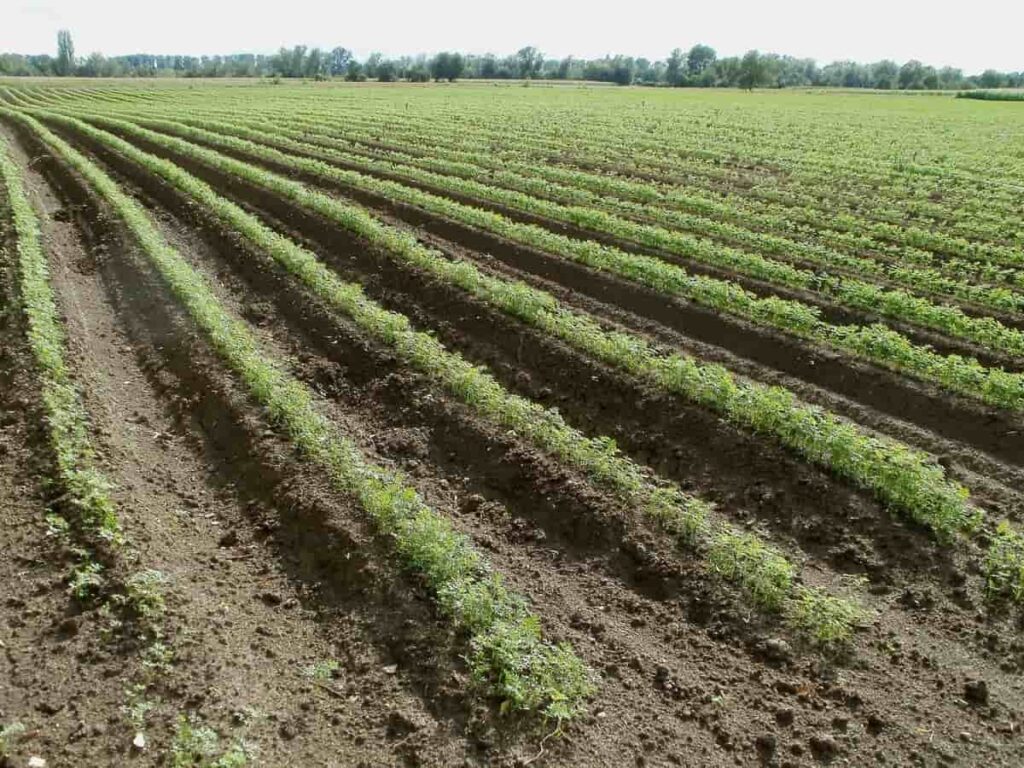Carrots are root vegetables typically orange, although they can also be white, yellow, purple, or red. Carrots are native to Europe and Asia and have been cultivated for centuries. Carrots are a popular food worldwide and are eaten both fresh and cooked. These are easy to grow and can be grown in various soil types. Commercial carrot farming is a profitable business anywhere in the world. With a solid business plan, anyone can succeed in commercial carrot farming. In this post, we will explore the carrot farming business plan along with other cultivation practices.

Carrot farming business plan
Advantages of carrot farming business
The carrot farming business has many advantages. One advantage is that carrot farmers can get their products to market quickly. Carrots are a fast-growing crop, so farmers can harvest them and get them to market in a matter of weeks. This allows farmers to take advantage of seasonal demand and get the highest prices for their carrots. Another advantage of the carrot farming business is that it is relatively low-risk.
Carrots are a hardy crop that can tolerate a wide range of growing conditions. Farmers can grow carrots even in poor soil quality or limited water resources. Finally, the carrot farming business is environmentally friendly. Carrots are a nitrogen-fixing crop, which means they help improve soil fertility. They also require less energy and water to grow than other crops, such as corn or wheat. This makes carrot farming an environmentally sustainable option for farmers.
How to prepare the soil for carrot farming
Preparing the soil for carrot farming is critical in ensuring a successful crop. Carrots are root vegetables that need loose, well-drained soil to grow properly. The best method and way to achieve this is to conduct a soil test and amend the soil accordingly. If your soil is too sandy, add some organic matter to help retain moisture.
If it is too clayey, work in some sand to improve drainage. Either way, you will also want to add some compost or manure to provide nutrients once you have amended the soil, till it to a depth of 8-10 inches to loosen it up. Now you are ready to plant.
Climate requirement for carrot farming
Carrots are a cool-season crop, which means they can tolerate some frost. In fact, frost improves the flavor of carrots. Carrots need about 3 months of cool weather to mature, so they are typically planted in early spring or late summer/early fall. Carrots need full sun to grow well but tolerate partial shade. Carrots prefer loose, sandy soil that is high in organic matter. The soil should be well-drained to avoid root rot.
Best time to plant carrot
The best time to plant carrots in spring, after the last frost. Carrot seedlings should be planted about 1/2 inch deep in soil that has been loosened and raked. After planting, water the seedlings well and keep the soil moist. Carrots will take about two weeks to germinate.
Carrot verities/Types
There are many different carrots, each with its unique flavor and texture. Here are some of the famous carrot varieties:
- Orange carrots are the most common type of carrot. They are typically sweet and juicy, with a slightly earthy flavor.
- Purple carrots are less sweet than orange and have a slightly spicy flavor.
- White carrots are the mildest-tasting variety and have a slightly sweet flavor.
- Yellow carrots are similar in taste to orange carrots but have a slightly nutty flavor.
- Green carrots are the least sweet of all the carrot varieties and have a grassy flavor.
- Gourmet carrots are often more expensive, but they can be worth the price for their unique flavor.
- Baby carrots: These are small, young carrots that are typically very sweet.
In case you missed it: Shrimp Farming Business Plan: Every Aqua Farmer Should Know Before Getting Started

Propagation in carrot farming
Carrots are typically propagated through seed but can also be propagated through root cuttings. Seed propagation is the most common method for carrots, as it is relatively easy and inexpensive. On the other hand, root cuttings are more difficult and expensive but can be used to propagate carrot plants that produce especially large or tasty roots.
To propagate carrots through seed, growers sow the seeds in well-drained, loose soil in a sunny location. Carrot seeds are tiny, so they should be sown thinly and lightly covered with soil. Carrot seeds should be sown at a depth of 1/4 to 1/2 inch. As the seeds germinate and the seedlings emerge, they need to be thinned to be spaced 4 to 6 inches apart.
On the other hand, root cuttings are taken from mature carrot plants. To do this, growers carefully dig up a mature carrot plant and sever a section of the root about 4 inches long. This root cutting is then planted in well-drained, loose soil in a sunny location. As with seed propagation, root cuttings should be thinned once they have germinated and the seedlings have emerged.
Where to purchase carrot seeds
The best place to purchase carrot seeds is from a reputable seed company. There are many different seed companies out there, so it is important to research to find one that offers high-quality seeds at a good price. There are certain things to consider when purchasing carrot seeds:
- You need to decide what type of carrot you want to grow. There are many varieties of carrots, so it is important to choose the right one for your needs.
- You need to decide how many seeds you need. It is best to purchase more than you think you need because some seeds may not germinate.
If you take the time to consider these factors, you will be able to find the best place to purchase carrot seeds for your needs.
Carrot seed rate per acre
The average carrot seed rate is about 2.5 to 3 pounds per acre. However, this can vary depending on the variety of carrot being grown, the soil type, and other factors.
Sowing method in carrot farming
Carrot farming is relatively easy, but there are a few key things to remember when seed sowing. First, carrots need deep, loose soil to grow correctly. The carrots will be stunted and deformed if your soil is too compacted. The best way to ensure loose soil is to mix in plenty of organic matter before planting. When it comes to planting depth, a good thumb rule is to plant the seeds twice as deep as their length.
So, if you’re using large seeds, plant them about 1 inch deep. If you’re using smaller seeds, plant them about 1/2 inch deep. Once planted, lightly press the soil down around the seeds, so they make good contact with the soil. Water the seeded area well and keep it moist until the carrots emerge. Once they’ve sprouted, thin the seedlings so that they’re about 4-6 inches apart. This will give them room to grow into healthy, full-sized carrots.
Mulching your carrot plants
Mulching your carrot plants is a great way to protect them from the elements and keep them healthy. The process of mulching helps to retain moisture in the soil, which is essential for carrot growth. It also prevents weeds from growing and competing with your carrots for nutrients. There are many different types of mulch that you can use on your carrot plants. Some common options include straw, hay, leaves, grass clippings, and wood chips.
You can also purchase mulch designed for farm/garden at your local nursery or garden center. When applying mulch to your carrot plants, leave a few inches of space around the base so that the stem is not covered. This will help prevent rot and allow the plant to breathe. Next, apply a 2 to 3-inch layer of mulch around the plants and replenish as needed throughout the growing season.
Carrot transplanting and spacing
When transplanting carrots, it is important to space them properly to ensure a good yield. Carrots should be transplanted into rows that are 12 inches apart, with plants spaced 3-4 inches apart within the row. If you are transplanting into a raised bed, the bed should be no more than 18 inches wide to reach the plants in the middle without stepping on the bed and compacting the soil.
In case you missed it: Bamboo Farming Business Plan: How Bamboo Could be the Next Eco-Friendly Business

Carrots can be transplanted at any time during the growing season, but it is best to do it when they are small, so they have less chance of being damaged. When transplanting, water the plants well and gently loosen the roots before placing them in the new location. Make sure to firm the soil around the plant and water again.
How to thin your carrot plants?
Carrot plants need to be thinned so that they have room to grow. When thinning, remove the weaker seedlings so the stronger ones can grow. Use your fingers to snap off the weak seedlings at the soil line to thin carrot plants. Be sure to leave about 3 to 4 inches between each remaining seedling.
How to care for carrot plants
Water your carrot plants regularly, especially during dry spells. Keep the soil moist but not soggy. Carrot plants need a lot of nitrogen, so they should be fertilized regularly. Use a high-nitrogen fertilizer and apply it according to the package directions. Keep your carrot plants from getting too much sun. They’ll produce smaller, less flavorful carrots if they’re in direct sunlight all day long. Harvest your carrots when they’re about 8 inches long. Pull them gently from the ground, careful not to damage the roots of other plants nearby.
Best fertilizers and manure compost for your carrot plants
Carrots are heavy feeders and need a lot of nitrogen, phosphorus, and potassium (NPK) for optimal growth. A balanced fertilizer like 10-10-10 or 8-8-8 is a good choice for carrots. Aside from this, you can also supplement the soil with these:
- Compost: Compost is an excellent all-around fertilizer for carrot farming. Compost adds essential nutrients to the soil and helps improve soil structure and drainage.
- Manure: Manure is another excellent all-around fertilizer for carrot farming. Like compost, it adds essential nutrients to the soil and helps improve soil structure and drainage.
- Blood meal: Blood is an excellent nitrogen source for healthy plant growth. It can also help deter pests and improve soil fertility.
- Fish emulsion: Fish emulsion is an excellent source of nitrogen, phosphorus, and potassium, all essential nutrients for carrot growth. It’s also rich in trace minerals that can promote healthy plant growth.
- Kelp meal: Kelp meal is an excellent source of potassium, essential for healthy plant growth. It can also help improve soil fertility and water retention.
When and how to water carrot crop
Watering your carrot plants is one of the most important aspects of carrot cultivation. Carrots require consistent moisture to grow properly. Therefore, carrots may need to be watered daily, depending on the climate. The best time to water carrots is in the morning before the sun gets too hot.
In case you missed it: Terrace Gardening ideas for Home in India: For Vegetables, Fruits, Flowers, and Herbs

This gives the carrot plants time to absorb the water before the day’s heat evaporates. Water should be applied evenly across the entire carrot bed, taking care not to wet the foliage. Soaker hoses or drip irrigation systems are ideal for watering carrots, as they evenly distribute water and minimize evaporation. If using a sprinkler, move it around so that all parts of the bed receive equal water.
How to control weeds in carrot crop
Weeds can be a major problem in carrot crops, competing with carrots for water, nutrients, and light. Left uncontrolled, weeds can reduce yields by up to 50%. There are several ways to control weeds in carrot crops, including:
- Hand weeding is the most labor-intensive option but can be effective if done regularly.
- Mulching: Placing a material layer (e.g., straw) over the soil can help prevent weeds from germinating.
- Herbicides: There are several herbicides available that are effective at controlling weeds in carrot crops. However, care must be taken to avoid harming the carrots themselves.
The best approach to controlling weeds in carrot crops is likely to combine these methods. Regular hand weeding combined with mulching and herbicides can help keep weed numbers under control and maximize yields.
Carrot Pests, diseases, and control
Pests and diseases are a constant threat to carrot crops. Some of the most common pests and diseases include:
- Aphids: These small, winged insects feed on the sap of plants, which can weaken and stunt growth. Usually, aphids can be controlled with insecticidal soap or neem oil.
- Cabbage loopers: The caterpillars of this moth feed on the leaves of plants, causing them to become ragged and stunted. Cabbage loopers can be controlled with Bacillus thuringiensis (BT) or spinosad.
- Carrot rust fly: The larvae of this fly feed on the roots of carrots, causing them to become deformed and discolored. Carrot rust flies can be controlled with traps or insecticides.
- Damping off: This is a fungal disease that affects seedlings, causing them to collapse and die. Damping off can be prevented using a sterile potting mix and keeping the growing area clean and debris-free.
- Downy mildew: This fungal disease causes the leaves of plants to become yellow and covered in fuzzy gray mold. Downy mildew can be controlled with fungicides.
In case you missed it: How to Grow Medicinal Plants at Home: in Pots, Terraces, and Backyard

When and how to harvest carrots
Carrots can be harvested anytime after reaching at least 4 inches in length (usually 70 days after planting). To harvest:
- Pull the carrot up by its green top.
- Leave about 2 inches of the stem attached to the carrot.
- If you’re planning on storing your carrots, wait to harvest them until after the season’s first frost. This will help to improve their flavor.
- After that, carrots can be stored in a cool, dark place for up to 3 months.
In case you missed it: How to Care for Dairy Goats: Shelter/Housing, Fencing, Feeding, and Disease Control

Carrot yield per acre
Several factors can affect carrot yields, including the type of soil, the amount of rainfall, the use of fertilizers and pesticides, and the age of the plants. The average yield for organic carrot production was just over 16,000 pounds per acre, while the average yield for conventional carrot production was almost 28,000 pounds per acre. With good cultivation practices, one can expect the average carrot yield per acre in the United States is about 24,000 pounds (in the USA).
- Budget Friendly Sheep Shed Ideas: Cheap and Low-Cost Tips
- How Much Do Cattle Farmers Make: Revenue Streams in Cattle Farming
- Management Pests and Diseases in Your Cotton Field
- Sheep Farming Business Plan for Beginners
- Aquaponic Farming at Home: A Step-By-Step Guide
- Profitable Village Farming Business Ideas in 2024
- High-Yield Aquaculture: Fast-Growing Fish for Farming
- Effective Fish Pond Construction Techniques for Beginners
- Irrigation and Water Management in Pineapple Farming
- Blossom to Harvest: Mastering Flowering and Pollination in Papaya Farming
- Pig Fattening Essentials: From Selection to Sale for Beginners
- Raising Wagyu Cattle: A Complete Guide for Premium Beef Production
- Soil Types and Their Water Holding Capacity
- Optimizing Irrigation Schedules for Coconut Groves for Enhanced Yield
- Espresso Your Garden: Coffee Grounds for Healthier Acid-Loving Plants
- The Best Soil Mix for Snake Plants: How to Mix Your Own Snake Plant Soil
- Green Thumb Success: Expert Tips for Cultivating Greenhouse Beans All Year Round
- Bloom All Year Round: The Ultimate Guide to Indoor Hyacinth Care
- Eco-Friendly Gardening: How to Make Liquid Fertilizer from Kitchen Waste
- Ultimate Guide to Grow Anise in Pots: Explore Seed Propagation to Harvesting
- Guide to Raising Chester White Pigs: Discover Breed Facts to Growth Management
- Mastering the Elegance: The Ultimate Guide to Weeping Cherry Tree Care, Planting, and Maintenance
- Ultimate Guide to Planting Garlic in Grow Bags: Growing Strategies for Beginners
- How to Fix Spider Plant Leaf-Related Problems: Natural and Organic Remedies
- 10 Reasons Why Your Tulsi Plant is Shedding Leaves: Home Remedies and Solutions
- Optimizing Growth and Yield: The Advantages of Palm Bunch Ash Fertilizer
- Utilizing Neem Oil Extract as a Natural Pesticide for Hydrangea
- From Soil to Harvest: Various Ways in Which Farmers Can Use AI Tools
- Steps to Encourage and Induce Citrus Flowers: A Comprehensive Guide
- How to Fix Snake Plant Leaf-Related Issues: Natural and Organic Remedies
- Transform Your Garden into a Fragrant Oasis with Raat Ki Rani (Night Blooming Jasmine)
- Discover the Ideal Chicken Breeds for Philippine Farms
- How to Create a Poultry Egg Farm Business Plan for Profits
- Grow Lemon Cucumbers Like a Pro: Insider Techniques for Bountiful Yields
- Ultimate Guide to Caring for Your Pink Princess Philodendron: Tips for Thriving Variegation
- Areca Nut Profit Per Acre: Calculating Yield and Cost of Cultivation
